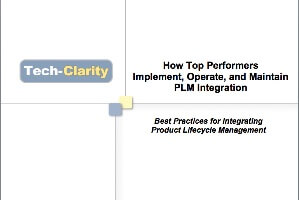 How Top Performers Implement, Operate, and Maintain PLM Integration – Best Practices for Integrating Product Lifecycle Management shares survey results detailing how Top Performers implement their PLM systems. The research uncovers integration challenges and best practices across the PLM Integration Lifecycle, recognizing that implementing integration is only the first step in the process.
How Top Performers Implement, Operate, and Maintain PLM Integration – Best Practices for Integrating Product Lifecycle Management shares survey results detailing how Top Performers implement their PLM systems. The research uncovers integration challenges and best practices across the PLM Integration Lifecycle, recognizing that implementing integration is only the first step in the process.
Please enjoy the summary below, or click the report to download a PDF overview (free of charge, no registration required).
For the full report, please visit our sponsor, Razorleaf (free of charge, registration required).
Table of Contents
 Executive Overview
Executive Overview- The Business Value of Integrating PLM
- When do Companies Begin Integrating?
- Introducing the PLM Integration Lifecycle
- Implementation Challenges
- Operation Challenges
- Maintenance Challenges
- Business Impacts
- Quantifying the Impact
- Identifying the Top Performers
- Top Performers Experience Fewer Negative Impacts
- Top Performers Integrate More
- Top Performers Integrate with More Advanced Tools
- Top Performers Integrate with More Advanced Enterprise Applications
- Top Performers Integrate More PLM Data
- Top Performers Use More Advanced Integration Techniques
- Focusing on the Future: The Impact of IoT on PLM Integration
- Conclusion
- Recommendations
- About the Author
- About the Research
- Copyright Notice
Executive Overview
Product Lifecycle Management (PLM) helps manufacturers in many ways ranging from operational efficiencies to top-line financial improvement. It improves business performance in multiple dimensions including increased revenue, reduced product cost, and decreased product development cost. But PLM is just one of many systems in the engineering and enterprise software ecosystems, and provides greater value when it shares data and connects workflows with other software. As reported in Product Lifecycle Management Beyond Managing CAD, “Top Performers are much more likely to integrate PLM with a host of other systems.”
We surveyed over 150 companies to understand their PLM integration strategy, processes, and technical enablers in order to understand how proper integration can extend PLM value. The findings indicate that the vast majority of manufacturers view PLM as “Strategic” or “Important.” It also finds that many believe that PLM integration will become even more strategic (and challenging) as IoT initiatives progress.
In order to understand how companies get the most business value from PLM integration, we identified manufacturers that were gaining the largest operational benefit from their PLM implementation, the Top Performers. These leaders achieve significantly better than average PLM business benefits. We analyzed what these companies do differently related to PLM integration in order to offer advice to poorer performing companies. The analysis determines that Top Performers in gaining the benefits from PLM:
 Are more likely to view PLM integration as strategic
Are more likely to view PLM integration as strategic- Integrate PLM to more design tools and more enterprise applications
- Integrate PLM to more advanced tools and applications
- Are more able to implement, operate, and maintain PLM integration in an agile, cost-effective way
- Experience fewer operational issues including:
- Needing to look for data in multiple systems
- Duplicate data entry
- Data inconsistency across systems
We also discovered that these Top Performers take different approaches to integrating PLM, leveraging a variety of techniques but opting toward more advanced, maintainable techniques like a hub and spoke approach. Read on to find out more about PLM integration and what sets the Top Performers apart across the PLM Integration Lifecycle spanning integration implementation, operation, and maintenance.
Conclusion
PLM helps companies improve product innovation, product development, and engineering efficiency and helps enhance communication across the enterprise and the supply chain. Improving PLM integration helps companies achieve the benefits PLM has to offer, making it a highly strategic investment. The level of importance, along with the level of complexity, will only increase as companies move to smarter, more connected products and the IoT.
Top Performers, those that get the most benefits out of their PLM systems, are more likely to view PLM integration as strategic. They integrate more design tools and enterprise applications with PLM, and integrate PLM to more advanced tools and applications. They also integrate more data, including more information that spans the enterprise and the supply chain. The leads us to the conclusion that better PLM integration is simply good business.
Top Performers take different approaches to integrating PLM, employing a variety of tools but more likely including adaptable techniques like a hub and spoke approach that provides benefits across the PLM Integration Lifecycle. The result is that these Top Performing companies are more able to implement, operate, and maintain PLM integration in an agile, cost-effective way and experience less need to look for data in multiple systems, perform less duplicate data entry, and find less data inconsistency across systems.
Recommendations
Based on our experience and the research for this report, Tech-Clarity offers the following recommendations:
- Manufacturers should integrate PLM with a broader number of enterprise applications and design tools
- Companies should integrate with more advanced systems, including those that extend beyond Engineering into the enterprise and the supply chain
- Companies should use a variety of integration techniques depending on the specific solutions and connectivity methods available, leveraging more advanced approaches such as hub and spoke when practical to provide more agility across the PLM Integration Lifecycle
- Manufacturers should consider outside expertise to fill the PLM integration knowledge gap
- Companies should focus integration plans and efforts beyond the initial implementation to optimize across the entire PLM Integration Lifecycle

